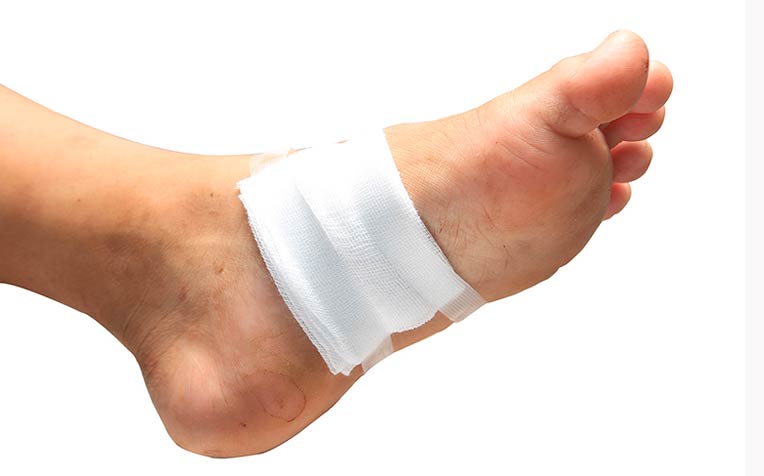
Diabetes foot wounds should only be cleansed with sterile water or saline, and covered with dressing at all times to prevent infections from occurring.
The Podiatry Department at Singapore General Hospital (SGH), a member of the SingHealth group, shares tips on what to avoid to prevent diabetes foot complications and what can be done.
What to avoid
To minimise risk of diabetes related foot complications, avoid the following:
Exposing feet to high or low temperatures

Do not use heat pads, a hairdryer, light therapy or hot foot soaks to warm your feet, and ice packs or cold foot soaks to cool your feet. They can result in skin burn injuries.
Why?
It is common for people with diabetes to develop a loss of sensation in the feet. When this happens, the person is not able to sense the change in temperature as a person with normal sensation would be able to. Thus, it is dangerous for people with diabetes to use heat pads, hairdryer, hot foot soaks or light therapy to warm their feet as they may burn their feet.
Likewise, the usage of ice packs or cold foot soaks is also not recommended. The skin tissue gets damaged when the skin comes into contact with very cold objects which may lead to an ice burn.
Also, avoid soaking the feet for prolonged periods of time as this could cause the skin to wrinkle and break down.
Foot basins can also contain germs which can enter skin breaks in the feet and cause infections.
 What you should do instead
What you should do instead
If your feet feel cold, wear a pair of thick cotton socks to warm them up.
For foot soaks, check the temperature of the water with your elbow or get your family member/caregiver to test the temperature of the water prior to placing your feet into the water.
Walking barefoot or wearing slippers

Why?
This exposes your feet to sharp objects in the surrounding environment, increasing your risk of getting cuts or injuries. Germs can enter through the skin breaks and cause an infection.
This is especially so for those with a loss of sensation in their feet as they are unable to feel the cut or injury and leave the skin break untreated.
 What you should do instead
What you should do instead
When going out, it is important to always wear a pair of covered shoes. Shoes should be worn together with cotton socks to absorb sweat. Ensure that socks are changed after each use for hygiene purposes.
At home, wear cushioning home slippers to protect your feet. Also, check your feet with a mirror daily to ensure there are no cuts, injuries or changes from the norm.
Walking on pebble foot reflexology paths, going for foot reflexology or massages

Why?
On a hot day, the pebbles on the foot reflexology paths readily absorb heat and can cause severe burns and infection to your feet. The uneven ground and any sharp objects in between the pebbles can also cause a foot injury.
The pressure exerted on the foot during foot reflexology or massage sessions may cause injuries to your foot as well.
Cleaning of foot wounds with seawater and/or going for fish spa

Why?
Seawater and fish spas are not sterile and contain many harmful germs and foreign particles. The risk of foot infection is high if wounds are washed with seawater.
Fish in the fish spa nibble the dead skin of people’s feet, and germs from one person can easily spread to another.
 What you should do instead
What you should do instead
Wounds should be cleansed with sterile water or saline prior to applying the dressing on the wound.
Leaving wounds exposed to air-dry

Why?
This exposes the wound to germs, and even flies in the environment.
Drying the wound with a fan or hairdryer will not help heal the wound faster, and may instead cause further complications.
The longer the wound is left uncovered, the higher are the chances of developing an infection at the wound site.
 What you should do instead
What you should do instead
Wounds should be covered with sterile dressing at all times to prevent infections from occurring.
Use of traditional remedies for wound care

There is no scientific evidence to prove that traditional medicated ointments are beneficial for wound care. In fact, some of the ingredients may even cause wound deterioration and delay wound healing.
 What you should do instead
What you should do instead
If you get any superficial wounds or cuts, cleanse them with an antiseptic solution such as iodine and cover with a dry dressing. If the wound fails to heal or worsens, please seek medical advice from the polyclinic, GP or hospital.
Click the next page to find out what to do during a diabetes foot emergency.
Click the link for ten steps to healthy feet.
Click the link to learn how diabetes affects the feet.
Because #healthiswealth #healthforgood
Ref: K21
Related article:
Essential Tips to Manage Diabetes Better



















 Get it on Google Play
Get it on Google Play